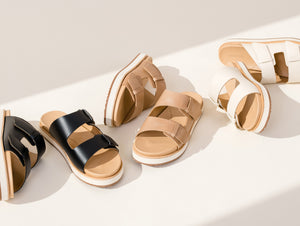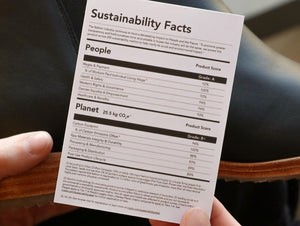How Our 0% Net Carbon Commitment Combats Climate Change
Creating nearly 10% of the world’s carbon footprint today and on track to make up 26% by 2050, the fashion industry is one of the worst contributors to climate change, emitting more emissions than the international aviation and shipping industries combined (Source: Ellen Macarthur Foundation). Not only is fashion one of the top 5 most polluting industries due to dirty, unregulated manufacturing, but 85% of the clothes we wear end up in landfills even though 95% could be reused or recycled (Source: Council for Textile Recycling, 2021).
We can all do better. We have to, as is often said, “there is no Planet B.”
We recognize that everything we make has an impact on the planet, and we believe the fashion industry can regenerate rather than deplete the environment if we measure our impact and invest in proven methods to counteract it. In this post, we are going to dig in on our commitment to reducing and offsetting 100% of our carbon emissions as a brand and why we believe all brands should aim to become 0% net carbon neutral.
Before we dive in on carbon neutrality, we have to be clear that there is far more to environmental responsibility than offsetting carbon emissions alone...
Why We Believe in a “Circular Fashion” Approach to Environmental Responsibility
“Sustainability” and “Eco-Friendly” to us mean far more than offsetting carbon emissions or one-off donations or products that use small fractions of responsibly sourced materials, etc. To us, environmental “sustainability” means taking EVERYTHING into consideration. This is why, in contrast to fast fashion’s “take, make, dispose” model, we believe in a “circular fashion” approach that takes environmental impact into account at all stages ranging from the initial design products, to the sourcing of materials, to manufacturing, to logistics to the final customer, to the end lifecycle of products post consumer use, and all steps in between.
Taking a circular fashion approach is a journey that we are very far from perfect on, but today, for us, starts as early as material selection at the design phase, which is why we’ve introduced upcycled and recycled materials into our design process and packaging and will continue to do so in years to come as our manufacturing capabilities expand. It’s also why we’ve transformed our supply chain in the last few years to allow for 95% of our leather uppers to originate from Leather Working Group Certified tanneries, which meet the highest standard of environmental responsibility in our industry. In a dirty industry where renewable energy is largely non-existent, it’s why solar panels span the roof of our factory in Peru, further reducing our carbon footprint. It’s why we have a Shoe Reclamation Program to incentivize customers to divert shoes from landfills at the end of their usage in a manner that upcycles and recycles relevant components while enhancing employment in developing countries.
And lastly, for example, it’s why our goal is to maintain 0% net carbon emissions through measuring, striving to reduce, and ensuring the offsetting of 100% of our carbon emissions from the start of our supply chain all the way to our customers’ doorsteps.
Our Environmental Conservation Work Since 2018
For over 4 years now, we have offset the carbon emissions of everything we have produced by partnering with Ecosphere+ to invest in forest conservation in the Cordillera Azul of the Peruvian Amazon, which is located in the same geographic region as our factory. We address climate change through an intersectional lens. This project is working in a huge landscape of 3.7 million hectares (nearly the size of the Netherlands) to protect 1.6 million hectares of threatened forest. It focuses on establishing sustainable livelihoods through technical assistance and support for transitioning land use to agroforestry systems for sustainable cocoa and coffee production. In addition, a wide community-driven program is helping tens of thousands of indigenous people gain access to basic services such as sanitation, health care and education. To date, the conservation project has created 665 jobs, 40% of which are held by women. Learn more about its positive social and environmental impact here.
We also recently began supporting conservation work in Nii Kaniti. Located adjacent to the Cordillera Azul, this project area is comprised of community land from seven indigenous communities located around the Ucayali River. Native communities are the second largest managers of forest land in Peru, therefore are key actors and critical to successful forest, biodiversity, culture and climate protection at the world scale. The project addresses the local, economic drivers of deforestation and forest degradation by supporting the development of socially inclusive businesses. To date, this project has created or supported 18 sustainable enterprises, which employ 357 people, 35% of whom are women. Learn more about this project’s impacts here.
Why We Partner with Climate Neutral to 3rd Party Verify Our Efforts
While for several years we have done the vast majority of heavy lifting in calculating and verifying the emissions of our own supply chain, we recognized the need for third party support and validation on two major fronts. First, the science behind measuring carbon emissions is complex. Calculating emissions is dependent on the work of climate experts, and accuracy is essential. Secondly, in an industry that’s become overrun with greenwashing, third party verification provides much needed credibility. In fact, 40% of 500 fashion brands recently surveyed by the Competition and Markets Authority claimed to be “eco-friendly,” but had no data to substantiate their claims. We’re passionate about providing public-facing data and 3rd party verification for all of our social and environmental practices because we believe that level of transparency is critical to the sustainability movement and garnering ongoing trust between brands and consumers.
Climate Neutral’s Methodology
Before we dive into our emissions, let’s review Climate Neutral’s methodology at a very high level. To keep it simple, Climate Neutral ensures that we are accurately measuring and offsetting our entire carbon footprint by requiring us to measure our emissions on their software tool, the Brand Emissions Estimator (BEE), a comprehensive platform built in partnership with climate experts from well respected organizations–Massachusetts Institute of Technology and CIRAIG, among others, operating in the carbon emissions accounting and lifecycle analysis fields. To certify, we share financial information and specific emissions data (i.e. total ton miles shipped, kilowatts of energy consumed, amount of leather hides purchased, etc.) into the BEE to arrive at an accurate estimate of our total carbon emissions. An analyst from Climate Neutral works directly with our team to ensure there are no discrepancies in the data, and then supports us with creating and implementing reduction plans to actually reduce our carbon footprint moving forward.
Nisolo’s Climate Neutral Certified Carbon Emissions Overview
As a brand, we are measuring, striving to reduce, and ensuring the offsetting of 100% of our carbon emissions, which most recently totaled and were confirmed by Climate Neutral to be 2,614 tons of CO2 in 2021. Here are our carbon emissions broken down into three categories: Nisolo Headquarters (which is primarily our Nashville office), our Supply Chain, and Nisolo Company-Wide, which is inclusive of everything.
While there are very few brands who share (or even track) their carbon emissions, we were able to gather a few stats that are publicly available from other similar brands to share context on how our total company output compares to other brands. Here are a few examples:
-
Nisolo – 2,614 tCO2e
-
Sunski – 917 tCO2e
-
Ministry of Supply – 2,534 tCO2e
-
Miir – 9,057 tCO2e
-
Peak Design – 34,009 tCO2e
-
Veja – 36,867 tCO2e
Our Positive Impact in the Peruvian Amazon
As a reminder, since deforestation is responsible for approximately 10% of all global greenhouse gas emissions, protecting mature trees that naturally capture CO2 is one of the greatest tools for combating climate change. We’re grateful to have the opportunity to focus our offsetting efforts within the same country where much of our manufacturing occurs. Through the support of our customers and in partnership with Climate Neutral and Ecosphere+, to date we have been able to protect:
864,168 trees covering an area of 162,052,823 square feet (that’s the same size as 1,264 soccer fields) from deforestation in the Amazon Basin and offset 8,364 metric tons of CO2.
Map of Cordillera Azul National Park
Source: Campo, Hilary and Wali, Alaka (2007)
In addition to our conservation work supporting the jobs of 1,022 people (many of whom are from indigenous communities in Peru, and 30%+ of whom are held by women), our offsetting efforts to date are equivalent to:
Progress & Learnings from Measuring Our Emissions
We’ve made some exciting progress on reducing our carbon footprint since our initial work began in early 2018 and since becoming Climate Neutral Certified in 2020. Thankfully, when we compare our data, we see a cumulative reduction in carbon emissions of 4.2% year over year from 2020 to 2021.
A few highlight areas that helped contribute to reducing our carbon footprint in 2021 included:
- Shipping more product from our factories to our distribution center by sea and truck rather than air freight.
- Tracking key carbon metrics with suppliers.
- Tracking emissions at a per product level through Doconomy’s 2030 Calculator.
- And, whereas most of the fashion industry’s supply chain is still dependent on dirty energy sources derived from fossil fuels, we’ve invested in and installed solar panels on the roof of our factory in Peru, making us the only shoe manufacturer in the country (and one of a handful in the world) using renewable energy. We’re thrilled to be championing clean energy and environmental progress in this manner!
As we move forward, we’ll be launching our first products made with recycled post consumer waste, reducing our packaging materials, and implementing resale to extend the life of our products.
We’d love your feedback on all of this, so please email us at support@nisolo.com with your suggestions and ideas.
A Call to Action
Given the dire reality of how the fashion industry is negatively impacting climate change, our hope is that all brands will commit to measuring, striving to reduce, and ensuring the offsetting of 100% of their carbon emissions. And, our desire is for all brands to commit to 3rd party verification of these efforts through partners such as Climate Neutral. As a customer, we encourage you to seek out the carbon footprint of the brands you support and ask them straight up what they’re doing to address their environmental impact. Together, we can make the fashion industry a vehicle for environmental progress and inspire other industries to follow suit.




























